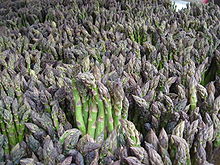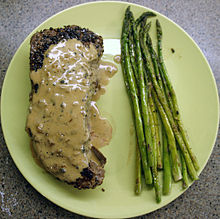Asparagus officinalis is a spring vegetable. A flowering perennial plant species in the genus Asparagus in the lily family, like its allium cousins, onions and garlic. It is native to most of Europe, northern Africa and western Asia, and is widely cultivated as a vegetable crop.
Asparagus officinalis is widely known simply as "asparagus", and may be confused with unrelated plant species also known as "asparagus", such as Ornithogalum pyrenaicum known as "Prussian asparagus" for its edible shoots.
 The English word "asparagus" derives from classical Latin, but the plant was once known in English as sperage, from the Medieval Latin sparagus. This term itself derives from the Greek aspharagos or asparagos, and the Greek term originates from the Persian asparag, meaning "sprout" or "shoot". Asparagus was also corrupted in some places to "sparrow grass"; indeed, the Oxford English Dictionary quotes John Walker as having written in 1791 that "Sparrow-grass is so general that asparagus has an air of stiffness and pedantry". In Gloucestershire and Worcestershire it is also known simply as "grass", and young ferns too small to cut are called "pru". Another known colloquial variation of the term, most common in parts of Texas, is "aspar grass" or "asper grass". In the Midwest United States and Appalachia, "spar grass" is a common colloquialism. Asparagus is commonly known in fruit retail circles as "Sparrows Guts", etymologically distinct from the old term "sparrow grass", thus showing convergent language evolution.
The English word "asparagus" derives from classical Latin, but the plant was once known in English as sperage, from the Medieval Latin sparagus. This term itself derives from the Greek aspharagos or asparagos, and the Greek term originates from the Persian asparag, meaning "sprout" or "shoot". Asparagus was also corrupted in some places to "sparrow grass"; indeed, the Oxford English Dictionary quotes John Walker as having written in 1791 that "Sparrow-grass is so general that asparagus has an air of stiffness and pedantry". In Gloucestershire and Worcestershire it is also known simply as "grass", and young ferns too small to cut are called "pru". Another known colloquial variation of the term, most common in parts of Texas, is "aspar grass" or "asper grass". In the Midwest United States and Appalachia, "spar grass" is a common colloquialism. Asparagus is commonly known in fruit retail circles as "Sparrows Guts", etymologically distinct from the old term "sparrow grass", thus showing convergent language evolution.It is known in French and Dutch as asperge, in Italian as asparago (old Italian asparagio), in Portuguese as aspargo, in Spanish as esparrago, in German as Spargel, in Hungarian as sparga. The Sanskrit name of Asparagus is shatavari and it has been historically used in India as a part of Ayurvedic medicines. In Kannada, it is known as ashadhi, majjigegadde or sipariberuballi.
In Thailand it is known as no mai farang (Thai: หน่อไม้ฝรั่ง), and in Vietnam mang tay which literally means "European bamboo shoots" and "Western bamboo shoots" respectively. The green asparagus is normally used in Thai cuisine.
Culinary
Only young asparagus shoots are commonly eaten: once the buds start to open the shoots quickly turn woody and become strongly flavoured.
The shoots are prepared and served in a number of ways around the world, typically as an appetizer or vegetable side dish. In Asian-style cooking, asparagus is often stir-fried. Cantonese restaurants in the United States often serve asparagus stir-fried with chicken, shrimp, or beef, and also wrapped in bacon. Asparagus may also be quickly grilled over charcoal or hardwood embers. It is also used as an ingredient in some stews and soups. In the French style, it is often boiled or steamed and served with hollandaise sauce, melted butter or olive oil, Parmesan cheese or mayonnaise. Tall, narrow asparagus cooking pots allow the shoots to be steamed gently, their tips staying out of the water. In recent years, almost as a cycle dating back to early culinary habits, asparagus has regained its popularity eaten raw as a component of a salad.
Green asparagus is eaten worldwide, though the availability of imports throughout the year has made it less of a delicacy than it once was. However, in the UK, due to the short growing season and demand for local produce, asparagus commands a premium and the "asparagus season is a highlight of the foodie calendar". In continental northern Europe, there is also a strong seasonal following for local white asparagus, nicknamed "white gold".
Nutritional and medicinal value
 Asparagus is low in calories and is very low in sodium. It is also a good source of vitamin B6, calcium, magnesium and zinc, and a very good source of dietary fiber, protein, vitamin A, vitamin C, vitamin E, vitamin K, thiamin, riboflavin, rutin, niacin, folic acid, iron, phosphorus, potassium, copper, manganese and selenium, as well as chromium, a trace mineral that enhances the ability of insulin to transport glucose from the bloodstream into cells. The amino acid asparagine gets its name from asparagus, the asparagus plant being rich in this compound. The second century physician Galen described asparagus as "cleansing and healing".
Asparagus is low in calories and is very low in sodium. It is also a good source of vitamin B6, calcium, magnesium and zinc, and a very good source of dietary fiber, protein, vitamin A, vitamin C, vitamin E, vitamin K, thiamin, riboflavin, rutin, niacin, folic acid, iron, phosphorus, potassium, copper, manganese and selenium, as well as chromium, a trace mineral that enhances the ability of insulin to transport glucose from the bloodstream into cells. The amino acid asparagine gets its name from asparagus, the asparagus plant being rich in this compound. The second century physician Galen described asparagus as "cleansing and healing".Nutrition studies have shown that asparagus is a low-calorie source of folate and potassium. Its stalks are high in antioxidants. "Asparagus provides essential nutrients: six spears contain some 135 micrograms (μg) of folate, almost half the adult RDI (recommended daily intake), 20 milligrams of potassium", notes an article in Reader's Digest. Research suggests folate is key in taming homocysteine, a substance implicated in heart disease. Folate is also critical for pregnant women, since it protects against neural tube defects in babies. Several studies indicate that getting plenty of potassium may reduce the loss of calcium from the body.
Particularly green asparagus is a good source of vitamin C. Vitamin C helps the body produce and maintain collagen, the major structural protein component of the body's connective tissues.
"Asparagus has long been recognized for its medicinal properties", wrote D. Onstad, author of Whole Foods Companion: A Guide for Adventurous Cooks, Curious Shoppers and Lovers of Natural Foods. "Asparagus contains substances that act as a diuretic, neutralize ammonia that makes us tired, and protect small blood vessels from rupturing. Its fiber content makes it a laxative too." It should be noted, however, that ammonia only "makes us tired" if we are in end stage liver failure.
Reference : http://en.wikipedia.org/wiki/Asparagus












0 comments:
Post a Comment